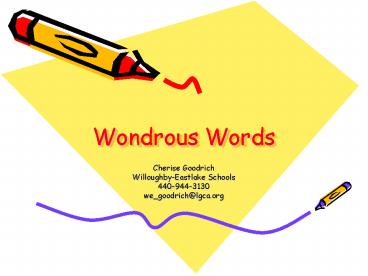Wondrous Words - PowerPoint PPT Presentation
1 / 15
Title: Wondrous Words
1
Wondrous Words
- Cherise Goodrich
- Willoughby-Eastlake Schools
- 440-944-3130
- we_goodrich_at_lgca.org
2
Vocabulary Development is an integral part of a
balanced reading program.
- Research says
- As students learn more vocabulary words they
become better readers. - Comprehension and vocabulary development go hand
in hand. - Children learn the meanings of most words
indirectly, through everyday experiences with
oral and written language. They do so by engaging
daily in oral language, listening to adults read
to them, and reading extensively on their own.
- Some vocabulary needs to be taught through direct
word instruction (teaching specific words, active
engagement with words, and repeated exposure to
words in many contexts, and word learning
strategies, using dictionaries and other
reference aids, using word parts, and using
context clues). - Vocabulary instruction should focus on important
words (key words to help readers make sense of
the text), useful words (words they will
encounter often), and difficult words (words with
multiple meanings, idiomatic words, etc.).
3
- A significant amount of vocabulary learning
takes place through incidental or environmental
learning, from wide reading, discussion,
listening, and media, for example, rather than
from direct instruction. (Blachowicz 2002)
4
What does good vocabulary instruction look like?
- Repeated exposure to words in oral and written
contexts - Example wardrobe in The Lion, the Witch, and
the Wardrobe - Use of dictionaries along with context clues and
text features - Using background knowledge (schema) to help
figure out meaning - Analysis of words in order to figure out
synonyms, antonyms, and part of speech
5
How does Wondrous Words demonstrate good
vocabulary instruction?
- Students are engaged in listening to a fluent
reader read from text. - Students have a purpose for readingto listen for
unknown/confusing words. - Students use context clues, picture clues, word
analysis, dictionary skills, and thesaurus skills
to determine meaning.
6
How do I begin to implement Wondrous Words
Wednesday in my classroom?
- Day 1
- Create a word jar in your classroom. It can be
on a bulletin board or an actual jar. It just
needs to be a place where your class can collect
their words. - Select text to read aloud, giving students a copy
of the text. (I do it on Wednesday). Use picture
books, portions of chapter books, newspaper, or
content area text. - As you read aloud, have students mark words they
hear/read that are unfamiliar but sound like good
words to know/words to grow. - After reading the story, make a list of words
chosen by the students on the board. - Students should choose one or two words (depends
on how many you want to do) to vote on.
7
Set Up
Words are added to the word jar at the end of
each week. At the end of the quarter the words
in the word jar are taken out and placed around
the jar on the bulletin board to make room for
the next quarter words. At the end of the year
there are over 50 new words on the bulletin board.
8
Day 1
Students place Post-It notes next to the words in
which they are voting.
The words of the week are placed on a white board
before going into the word jar.
9
How do I begin to implement Wondrous Words
Wednesday in my classroom?
- Day 2
- Students are given a graphic organizer page. You
can copy it back to back if you are focusing on
two words. - As a class identify the sentence the word was
used in and then decide the context clues and
picture clues that were evident in the story. If
there were no clues (which happens once in a
while) then note that there were no clues given.
- After the clues have been identified, students
look up the words in their dictionaries and
decide what the part of speech is for that word.
They also draw a picture of the words meaning
and write the word in a sentence. The sentence
needs to be detailed enough to show that they
know what the word means (i.e. I am intricate.
is not acceptable.)
10
Graphic organizer for grades 1-2
11
- To begin using the graphic organizer, also called
a concept map, START SMALL at first - Expect students to do 3-4 tasks on the organizer
rather than the entire page. For example, start
with - Write word
- Sentence word was found
- Context clues
- My picture
12
Graphic organizer for grades 3-5
13
Day 2
Students work independently to find the words in
the dictionary and to create a sentence for the
word.
Information can be displayed on an overhead,
chalkboard, or a projector.
14
Extensions or Additional Activities
- Students can take home their Wondrous Words
binder, a binder that is divided into three
sections as follows - Alphabetical order
- Synonyms/Antonyms
- Theme pages (feelings/emotions, action verbs,
solar system) - Students can record other texts where they find
past wondrous words that have been studied. - The graphic organizer page can be used in the
content areas for vocabulary lessons. - Students can write a story, poem, skit, song,
etc. using a variety or specified number of words
in the word jar. - Younger students can illustrate the words or
create a story using pictures to show
understanding of word meaning. - At the end of the year the words can be given
away, like Donovan did in Donovans Word Jar.
15
References
http//www.nifl.gov/partnershipforreading/explore/
vocabulary.html
- The Partnership for Reading
- Blachowicz, Fisher. Teaching Vocabulary in All
Classrooms, 2002 - Logan, Nichols, Ruley. Vocabulary instruction in
a balanced reading program, The Reading Teacher,
52, 336 346, December 1998/January 1999 - Word Detectives, Dodie Ainslie The Reading
Teacher, 54, 360 362, December 2000/January
2001































